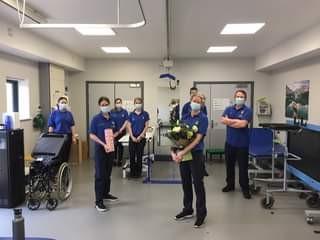Frenchay Brain Injury Rehabilitation Unit

The residual clinical facility on the former Frenchay Hospital site is the Brain Injury Rehabilitation Unit, known as ‘the BIRU’. It is a specialist neurological rehabilitation centre which opened on its current site in Frenchay in 2001, and in 2016 a new building was added, creating a total of 52 inpatient beds with supporting therapeutic facilities including two gyms, a small hydrotherapy pool, adapted kitchens and social areas.
Patients are admitted to BIRU from Southmead Hospital, Bristol Royal Infirmary and other regional acute hospitals, following a brain injury which may be due to trauma, stroke, or other illnesses of the nervous system. The average length of stay is a little under 4 months and treatment is provided by the NHS, for patients with complex difficulties requiring specialist rehabilitation.
A large team of staff is employed at BIRU – approximately 250 people – including registered nurses and nursing assistants, doctors, physiotherapists, speech and language therapists, occupational therapists, clinical psychologists, receptionists, administrators, cooks, housekeeping staff, drivers and maintenance staff. Some have been working at the centre ever since its first opening whilst many have joined in the last few years.
On admission to BIRU, many patients are unable to communicate, move around independently, eat or drink following their brain injury, or may have experienced changes to cognitive (thinking) skills. With the help and guidance of the expert team at BIRU, many are able to achieve huge improvements in their abilities and return to live in the community with greater independence.
The BIRU is accredited with Headway, the Brain Injury Association under their ‘Approved Provider Scheme’, a robust system of assessment, involving on-site evaluation of evidence and discussion with staff, patients, and families. It is an important accreditation, as it provides patients and their families with a sign of quality that can help with their decision-making.
‘Women in Innovation’ Award 2021
Innovate UK is the UK’s national innovation agency, and in 2016 it launched a ‘Women in Innovation’ campaign, aiming to find and engage more women in the UK with brilliant ideas for innovation, and to provide these women with access to advice, funding, and connections to help them rapidly achieve their business ambitions. Last year, out of 750 applications, 40 winners were chosen across a wide range of economic activity, each to receive a one-year tailored package of financial support, coaching, mentoring, and business growth opportunities.
One of the 2021 winners was Caz Icke (pictured, above), a Specialist Physiotherapist at the Frenchay BIRU, awarded for the development of her pioneering SoleSense product, a customisable rehabilitation solution designed to help individuals who have balance and walking difficulties as a result of brain injuries, strokes, and other neurological conditions.
The objective was to enable patients to do more independent rehabilitation, given the shortage of available time that therapists can spend with any individual patient.
The product was developed with a focus on neurological conditions that affect balance and walking. SoleSense uses wireless pressure-sensing insoles to deliver auditory and visual biofeedback via an app. They can be worn continuously to improve performance in balance and walking, encouraging self-management as a lifestyle choice in a fun and engaging way. It allows patients to track their own progress and to set collaborative goals with their therapists. They can be used throughout the rehabilitation pathway. The main task is ‘How to increase the level of repetitions of movement needed to produce lasting change in the nervous system that allows carry over of functional gains.’

Caz, seen here at the presentation alongside some of her colleagues, said
“The Award has provided a fantastic level of validation to this project, and kickstarted the product into the next phase of its research and development life cycle.“